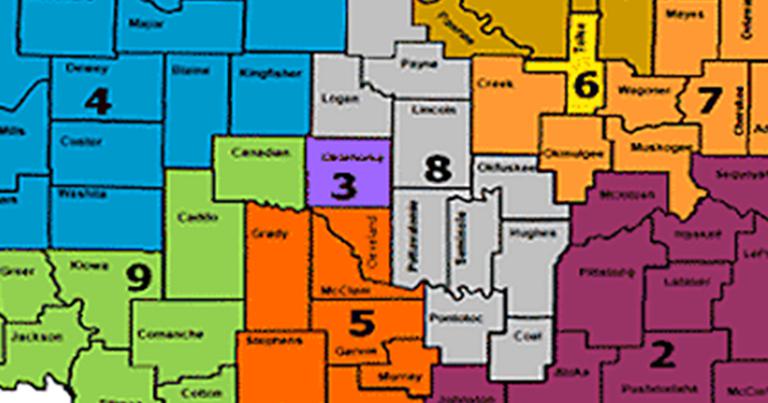
Judicial Reform
Mike Brake | April 4, 2019
Judicial-selection reform clears Senate committee
Mike Brake
Legislation making its way through the Oklahoma Legislature would reform and modernize the 1967-era geographical districts by which state Supreme Court and Court of Criminal Appeals judges are appointed.
Proponents say population shifts in the past half-century have concentrated lawyers who are eligible for the high courts in the major metropolitan areas, drastically limiting the talent pool in certain mostly rural districts. Opponents say that is precisely why they oppose the reforms, which they fear would lead to a Supreme Court heavily weighted against rural interests.
House Bill 2366, by Rep. Chris Kannady, R-Moore, and Senate Bill 973, by Sen. Julie Daniels, R-Bartlesville, would both retain the nine-justice Supreme Court structure but require that five of the justices be appointed from the five Congressional districts, while the other four would be drawn from a statewide at-large pool. Kannady and Daniels each chair their chamber’s respective Judiciary Committee.
The five Court of Criminal Appeals judges would come from the congressional districts. They were previously appointed from districts drawn up long ago that do not reflect current population data. Since the congressional districts are reapportioned every decade, the criminal court would automatically follow population trends.
The new Supreme Court districts would take effect as current justices reach the end of their terms, so the proposed bills would not result in immediate or wholesale turnover on the court.
Daniels said the primary reason for her legislation is that Oklahoma needs “a broad and deep pool of candidates to serve on the court.” She said there are too few potential applicants in some of the current districts to assure a group of qualified applicants when the seat attached to that district becomes vacant.
The modern method of selecting appellate court judges was created in the wake of the mid-1960s Supreme Court bribery scandals that featured the impeachment and subsequent criminal convictions of Justices N. S. Corn, Earl Welch, and N. B. Johnson. All had been elected by the people under the system that was first created during the populist wave that surrounded the creation of the Oklahoma Constitution in 1907.
Those judges were found to have accepted hundreds of thousands of dollars in bribes over the years to decide cases on behalf of the corrupting litigants. Part of the fallout was the adoption of a plan pushed by the Oklahoma Bar Association to abandon the direct election of appellate judges.
In its place the state created a nine-district map with one district each in Oklahoma and Tulsa Counties. That means that less than one-third of the justices come from areas that grew to contain more than two-thirds of the state’s population.
Under the current system, a Judicial Nominating Commission screens applicants from a district and submits three finalists to the governor, who must make his or her appointment from that pool. Voters can later vote to retain or remove appellate judges at the end of their terms. None of these judges has ever lost a retention vote.
As population has shifted towards the urban areas in ensuing decades, some of the old judicial districts have seen the number of lawyers qualified for consideration decline significantly. According to recent news coverage, at least two districts have fewer than 400 licensed attornies. In some cases it is a struggle to even get three candidates to apply for consideration.
Oklahoma City attorney A. J. Ferate said he supports the proposed reforms for the very reason Daniels cited.
“The way we select judges in comparison to other states is very unique,” Ferate said. He noted that the recent appointment of Oklahoma Supreme Court Justice Patrick Wyrick to the federal bench could lead to a vacancy, but there are only about 350 licensed attorneys in that district.
Opponents decry the proposal as weakening rural Oklahoma.
“Make no mistake about it, it reduces the likelihood of rural attorneys being selected to serve on the Oklahoma Supreme Court,” Rep. David Perryman, a Chickasha Democrat and attorney, said during the March 6 floor debate on the House bill. “This plan will ultimately reduce and possibly extinguish rural attorneys serving on the Oklahoma Supreme Court.”
He suggested urban attorneys would not understand the issues facing rural Oklahomans.
Both Ferate and Daniels disagreed.
“I’m concerned more about their jurisprudence than their geography,” Daniels said, noting that justices should decide cases on their overall legal merits rather than on local politics.
Ferate agree and noted a number of recent major case decisions have not shown an urban-rural divide on the court. Justice Yvonne Kauger, he said, represents western and northwestern counties but has frequently ruled against agricultural interests in past cases.
He also noted that most state appellate judges must relocate to Oklahoma City after their appointment to be near the court. Unlike legislators, who may live in their home districts most of the year, the judges are full-time court officials and could not be expected to retain dual residences.
Because SB 973 did not emerge from the Senate, HB 2366 has become the primary legislative vehicle for the reform effort. HB 2366 passed the Oklahoma House of Representatives by a 70-26 vote and this week passed out of the Senate Judiciary Committee on a 9-5 vote. It now awaits consideration from the full Senate.
Mike Brake
Independent Journalist
Mike Brake is a journalist and writer who recently authored a centennial history of Putnam City Schools. A former reporter at The Oklahoman (his coverage of the moon landing earned a front-page byline on July 21, 1969), he served as chief writer for Gov. Frank Keating and for Lt. Gov. and Congresswoman Mary Fallin. He has also served as an adjunct instructor at OSU-OKC, and currently serves as public information officer for Oklahoma County Commissioner Brian Maughan.